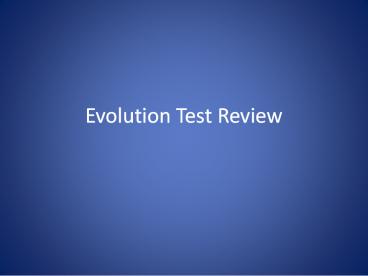Evolution Test Review - PowerPoint PPT Presentation
1 / 16
Title:
Evolution Test Review
Description:
Evolution Test Review 1. Give a definition for evolution. Why do living things need to evolve? Definition: species change over time As the environment changes, living ... – PowerPoint PPT presentation
Number of Views:199
Avg rating:3.0/5.0
Title: Evolution Test Review
1
Evolution Test Review
2
1. Give a definition for evolution. Why do
living things need to evolve?
- Definition species change over time
- As the environment changes, living things need to
survive, so they must change as time goes on
3
2. How are fossils dated?
- Radiometric/ Radiocarbon Dating measures the
amount of radioactive isotopes in a fossil to
determine its age - Pro can give you the exact age of a fossil
- Con cant be used on really old fossils because
the radioactivity goes away with time - Relative Dating compares the age of a fossil to
other fossils found in the same rock layer - Pro can be used to give you an estimated age of
really old fossils - Con rock layers can be shifted by earthquakes or
mudslides and this can give an inaccurate estimate
4
3. How can we get evidence for evolution from the
fossil record?
- The fossil record shows us how living things have
changed their forms over time
5
4. What are homologous structures? Give an
example. How do they provide evidence for
evolution?
- Similar structures with different functions
- Example a humans arm and a bats wing
- Evidence they show that there was a common
ancestor
6
5. What are vestigial structures? Give an
example. How do they provide evidence for
evolution?
- Structures that no longer serve a purpose but had
a purpose in an ancestor - Example Tailbone in humans wings on flightless
birds - Evidence show how things change over time
7
6. How does embryology (study of
embryos/development) provide evidence for
evolution?
- Similarities among embryos show a common ancestor
8
7. Explain Charles Darwins discoveries (finches
and tortoises).
- Finches
- Darwin noticed that where there were nuts for
food, the finches had short, hard beaks - Where there was fruit and insects for food, the
finches had long, thin beaks - Tortoises
- Darwin noticed that where there was low
vegetation, the tortoises had short legs and
necks - where there was high vegetation, the tortoises
had long legs and necks
9
8. What are adaptations? Give an example of an
adaptation
- Adaptation a beneficial change that allows an
organism/species to survive - Example thick fur on a rabbit that lives in the
arctic
10
9. How has the earth changed over time (timeline
events)?
- Earth changed and as it did, life evolved
- Earth was formed
- The first life appeared (single-celled)
- Oxygen appeared
- Plants and animals appeared (multicellular)
11
10. How are humans similar to and different from
other organisms?
- Similar
- Mammals (hair, live birth, produce milk)
- Primates
- Skeletons have similarities (homologous
structures) - Different
- Written communication
- Opposable thumbs
- Walk upright
- Large brains
12
11. What can we learn by studying cladograms?
- Cladograms show
- Shared traits
- The order the traits appeared in
- Probable relationships
13
12. How do you read a cladogram?
- Reads from the bottom up
- Oldest/most common trait at the bottom
- Newest/least common trait at the top
- Each organism on the cladogram has all the traits
below it
14
13. What are the different taxonomic groups from
largest to smallest? What can classifying things
tell you about evolution?
- Kingdom, Phylum, Class, Order, Family, Genus,
Species - Classification can tell you how closely related
two species are and how recently they shared a
common ancestor the more of the above groupings
they have in common, the more closely related
they are
15
14. What are the three domains and the kingdoms
that fit into each?
- Domain Bacteria
- Kingdom Eubacteria
- Domain Archaea
- Kingdom Archaebacteria
- Domain Eukarya
- Kingdom Animal
- Kingdom Plant
- Kingdom Protist
- Kingdom Fungi
16
15. How do you use a dichotomous key? What can a
dichotomous key be used for?
- Read through each paired statement and answer yes
or no and follow the instructions until you reach
an identified object - This key can be used to identify unknown objects.































